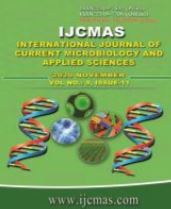


 National Academy of Agricultural Sciences (NAAS)
National Academy of Agricultural Sciences (NAAS)

|
PRINT ISSN : 2319-7692
Online ISSN : 2319-7706 Issues : 12 per year Publisher : Excellent Publishers Email : editorijcmas@gmail.com / submit@ijcmas.com Editor-in-chief: Dr.M.Prakash Index Copernicus ICV 2018: 95.39 NAAS RATING 2020: 5.38 |
Dalpatsagar reservoir is one of the oldest water bodies in Jagdalpur city at Bastar region of Chhattisgarh state. The water bodies is severely infested with different kind of aquatic weed species throughout the year since last decade and it modified the structure of habitat and influenced the aquatic organism. The physico-chemical properties of Dalpatsagar reservoir was changed with season year after year that influence the quality of water and pond ecosystem. The study was carried out at Dalpatsagar reservoir during June 2019 to May 2020 throughout the year. To assess the physico- chemical properties of pond water sample was collected from 11 different locations at Dalpatsagar reservoir. The physico-chemical properties of Dalpatsagar reservoir was observed significantly varied with different season, the maximum value of pH 8.31 and EC 0.47 dSm-1 was recorded in summer season at site of Jhada Tarae (JT) while the minimum value of pH 7.13 at the site of Mundra Dhipka (MD) and EC 0.21dSm-1 at Housing Board Drainage (HBD) was recorded during monsoon season. The value of TDS was highly varied with different season, the TDS was maximum 301.60 mg/L at Jhada Tarae (JT) in summer season while it is observed minimum 202.40 at Jhada Tarae (JT) during monsoon season. The amount of CO3 and HCO3 81.76 mg/L and 306.61 mg/L respectively, was observed higher during winter season while it was minimum during summer season. Dalpatsagar reservoir was severely infested with 20 major aquatic weeds species out of them the 7 most dominant weed species are Eichhornia crassipes, Pistia stratiote, Ipomoea aquatica, Nelumbo nucifera, Alternanthera philoxeroides, Nymphaea rubra and Hydrilla verticillata were found throughout the year. The weed density and weed dry matter was observed monthly in throughout the year. The weed density plant/m2 was observed higher with Hydrilla verticillata followed by Pistia stratiote and Eichhornia crassipes during September to January month while the weed dry weight g/m2 was found higher with Eichhornia crassipes followed by Nelumbo nucifera and Nymphaea rubra at throughout the year.
 |
 |
 |
 |
 |